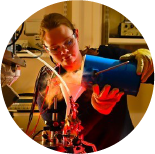These days it seems like all the big tech companies are investing in developing self-driving cars. How do these cars avoid running into other things around them? Most self-driving cars are relying on a technology called automotive lidar. Using a number of lasers and detectors, this allows the self-driving cars to see their surroundings better than the human eye.
Can cars, see? Most cars on the market today cannot see as such – not like us, in any case. That said, with an array of sensors, they can get surprisingly close. More and more, cars are being sold with advanced driver-assist systems, including features such as automatic emergency braking, blind spot detection, lane-keep assistance, and adaptive cruise control. So far, these features have relied on cameras, but a new technology is increasingly replacing these. If you’ve ever seen a self-driving car, you may have recognised it by a large moving sensor on its roof. This is a LiDAR system, and it is becoming the predominant technology behind most autonomous vehicle prototypes.
LiDAR (light detection and ranging) allows these cars to produce a 3D image of their surroundings. Like its cousin technologies radar (radio detection and ranging) and sonar (sound navigation and ranging), LiDAR detects the proximity of surrounding objects to its sensors. However, instead of using sound waves or radio waves, LiDAR uses infrared light waves.
LiDAR uses a pulsed infrared laser for object detection, which outputs highly directional infrared light that is invisible to human eyes.
Why light?
The use of infrared light offers a few advantages over traditional cameras. Lidar uses a pulsed infrared laser for object detection, which outputs highly directional, infrared light that is invisible to human eyes. This allows a LiDAR system to detect objects from a few meters to a few hundred meters away. The laser beam has a high spatial resolution, forming a high-resolution 3D characterisation of the surrounding area. Lidar systems also have a large field of view, with some systems able to see a complete 360 degrees.
The low-cost camera modules currently used can see in colour, but they still require extensive onboard processing. This need for extra processing power makes a self-driving car more complex in a way which is unnecessary with a LiDAR system. The real advantage of LiDAR over cameras can be seen on dark, moonless nights, during the bright noon sun, or in harsh weather such as rain or snow. Without sufficient contrast, camera systems are susceptible to white out where there is not enough detail to function. Lidar, however, works well both day and night, and recent advancements have further improved LiDAR’s performance in adverse weather conditions.
How exactly does LiDAR work?
A LiDAR system has three main components: a laser, a detector, and a processor. A laser is pulsed millions of times per second. Each of these pulses interacts with the surrounding environment, and some or all of the light reflects off objects, such as people walking by or other cars, before returning to the detector. The detector measures the characteristics of the reflected return signal including pulse power, round-trip time, phase shift, and pulse width. Knowing the time taken by the light pulse to be reflected and returned to the detector, the distance of that object in relation to the sensor (and therefore the self-driving car) can be calculated.
LiDAR systems allow cars to create a ‘depth map’ – a precise three dimensional image of the environment – by combining results from millions of pulses of light.
Combining results from millions of pulses of light, LiDAR systems allow these cars to create a ‘depth map’ – a precise three-dimensional image of the environment. This map is continually updated as the laser scans across the surrounding area and the information from reflected signals is processed. The vehicle then uses this to detect, identify, and decide how to avoid objects in its path.
Automotive LiDAR
With the rise in research on self-driving cars, smaller and cheaper LiDAR systems are being developed. LiDAR systems are now being integrated into advanced driver-assist systems in high- end mainstream cars, either supplementing camera systems already in use or, in some cases, replacing them altogether. Using a system of 8 to 128 LiDAR sensors, a car’s control systems can produce a map of its surrounding environment. A 3D scan of the environment is used to detect any surrounding or incoming objects, with millimetre accuracy. Scanning while driving at high speeds allows the detection system to know how fast an object is approaching, and whether drastic action is needed to avoid a collision. For a system like this, it is important to know whether the oncoming object is another car, or a plastic bag drifting in the wind. LiDAR systems have inbuilt detection software that can recognise specific objects. With huge libraries of objects to draw on, their systems are constantly improving. Using machine learning, cars are increasingly capable of learning new objects as they encounter them, adding them to their libraries of data and detecting them more easily in future.
Hundreds of start-up companies are working on LiDAR systems alone, not to mention the other parts the autonomous vehicle needs. The widespread use of driverless cars is increasingly likely in the near future, and the race to be the first mass producers of these cars continues to spur research on. LiDAR will arguably be the most important component to the success of autonomous vehicles, but there is a lot of work necessary to perfect the technology.
Download PDF
If you wish to save, or print, this article please use this pdf version »
Learning resource
We have created learning notes to assist students and educators to further investigate the topics covered in this article. You can download the learning resource here »


